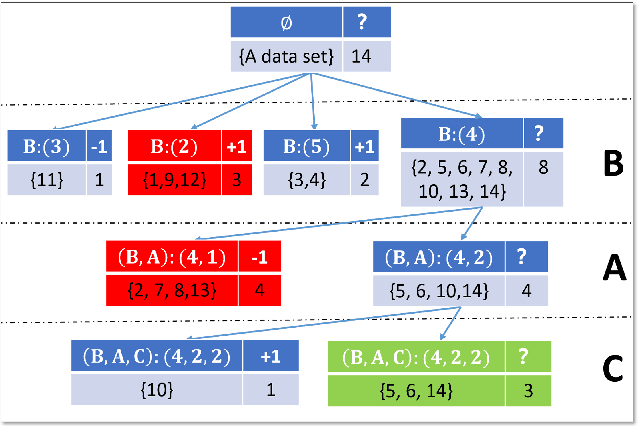Xinyu Bai
J-DDL: Surface Damage Detection and Localization System for Fighter Aircraft
Jun 12, 2025Abstract:Ensuring the safety and extended operational life of fighter aircraft necessitates frequent and exhaustive inspections. While surface defect detection is feasible for human inspectors, manual methods face critical limitations in scalability, efficiency, and consistency due to the vast surface area, structural complexity, and operational demands of aircraft maintenance. We propose a smart surface damage detection and localization system for fighter aircraft, termed J-DDL. J-DDL integrates 2D images and 3D point clouds of the entire aircraft surface, captured using a combined system of laser scanners and cameras, to achieve precise damage detection and localization. Central to our system is a novel damage detection network built on the YOLO architecture, specifically optimized for identifying surface defects in 2D aircraft images. Key innovations include lightweight Fasternet blocks for efficient feature extraction, an optimized neck architecture incorporating Efficient Multiscale Attention (EMA) modules for superior feature aggregation, and the introduction of a novel loss function, Inner-CIOU, to enhance detection accuracy. After detecting damage in 2D images, the system maps the identified anomalies onto corresponding 3D point clouds, enabling accurate 3D localization of defects across the aircraft surface. Our J-DDL not only streamlines the inspection process but also ensures more comprehensive and detailed coverage of large and complex aircraft exteriors. To facilitate further advancements in this domain, we have developed the first publicly available dataset specifically focused on aircraft damage. Experimental evaluations validate the effectiveness of our framework, underscoring its potential to significantly advance automated aircraft inspection technologies.
SAR to Optical Image Translation with Color Supervised Diffusion Model
Jul 24, 2024Abstract:Synthetic Aperture Radar (SAR) offers all-weather, high-resolution imaging capabilities, but its complex imaging mechanism often poses challenges for interpretation. In response to these limitations, this paper introduces an innovative generative model designed to transform SAR images into more intelligible optical images, thereby enhancing the interpretability of SAR images. Specifically, our model backbone is based on the recent diffusion models, which have powerful generative capabilities. We employ SAR images as conditional guides in the sampling process and integrate color supervision to counteract color shift issues effectively. We conducted experiments on the SEN12 dataset and employed quantitative evaluations using peak signal-to-noise ratio, structural similarity, and fr\'echet inception distance. The results demonstrate that our model not only surpasses previous methods in quantitative assessments but also significantly enhances the visual quality of the generated images.
Accelerating Diffusion for SAR-to-Optical Image Translation via Adversarial Consistency Distillation
Jul 08, 2024



Abstract:Synthetic Aperture Radar (SAR) provides all-weather, high-resolution imaging capabilities, but its unique imaging mechanism often requires expert interpretation, limiting its widespread applicability. Translating SAR images into more easily recognizable optical images using diffusion models helps address this challenge. However, diffusion models suffer from high latency due to numerous iterative inferences, while Generative Adversarial Networks (GANs) can achieve image translation with just a single iteration but often at the cost of image quality. To overcome these issues, we propose a new training framework for SAR-to-optical image translation that combines the strengths of both approaches. Our method employs consistency distillation to reduce iterative inference steps and integrates adversarial learning to ensure image clarity and minimize color shifts. Additionally, our approach allows for a trade-off between quality and speed, providing flexibility based on application requirements. We conducted experiments on SEN12 and GF3 datasets, performing quantitative evaluations using Peak Signal-to-Noise Ratio (PSNR), Structural Similarity Index (SSIM), and Frechet Inception Distance (FID), as well as calculating the inference latency. The results demonstrate that our approach significantly improves inference speed by 131 times while maintaining the visual quality of the generated images, thus offering a robust and efficient solution for SAR-to-optical image translation.
Hierarchical Uncertainty Estimation for Medical Image Segmentation Networks
Aug 16, 2023



Abstract:Learning a medical image segmentation model is an inherently ambiguous task, as uncertainties exist in both images (noise) and manual annotations (human errors and bias) used for model training. To build a trustworthy image segmentation model, it is important to not just evaluate its performance but also estimate the uncertainty of the model prediction. Most state-of-the-art image segmentation networks adopt a hierarchical encoder architecture, extracting image features at multiple resolution levels from fine to coarse. In this work, we leverage this hierarchical image representation and propose a simple yet effective method for estimating uncertainties at multiple levels. The multi-level uncertainties are modelled via the skip-connection module and then sampled to generate an uncertainty map for the predicted image segmentation. We demonstrate that a deep learning segmentation network such as U-net, when implemented with such hierarchical uncertainty estimation module, can achieve a high segmentation performance, while at the same time provide meaningful uncertainty maps that can be used for out-of-distribution detection.
An Efficient and Accurate Rough Set for Feature Selection, Classification and Knowledge Representation
Jan 12, 2022



Abstract:This paper present a strong data mining method based on rough set, which can realize feature selection, classification and knowledge representation at the same time. Rough set has good interpretability, and is a popular method for feature selections. But low efficiency and low accuracy are its main drawbacks that limits its application ability. In this paper,corresponding to the accuracy, we first find the ineffectiveness of rough set because of overfitting, especially in processing noise attribute, and propose a robust measurement for an attribute, called relative importance.we proposed the concept of "rough concept tree" for knowledge representation and classification. Experimental results on public benchmark data sets show that the proposed framework achieves higher accurcy than seven popular or the state-of-the-art feature selection methods.
 Add to Chrome
Add to Chrome Add to Firefox
Add to Firefox Add to Edge
Add to Edge